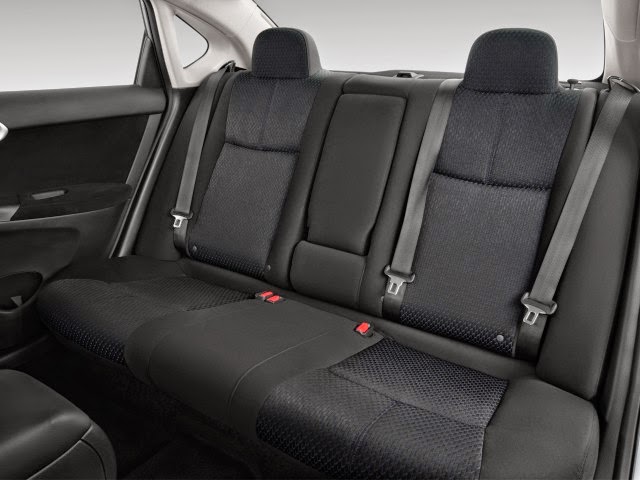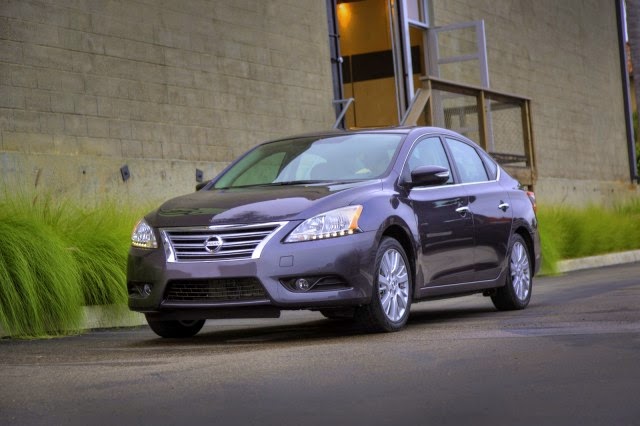
- 2014 Nissan Sentra Reviews
 |  |  |
 |  |  |
The Sentra was completely redesigned last model year, inheriting some of the larger Altima’s design language; in short, the look is more mature, with some curvier, more nuanced, Infiniti-esque sheetmetal. And we suspect it conspires to become something sexier than Sentras of the past ever were.
We’ll leave it to you to decide how sexy the look is [hint: we’re not all that convinced]. From the front, the Sentra has nearly the same look as the Altima, with a chrome-framed grille that widens upward, flowing into contour lines that stream outward over the hood to the A-pillar. Alongside, just as in the Altima, there’s an interesting crease that starts just over the front wheels and flows organically into the rear deck. The Sentra’s tail is more squared off, but it does have the same sort of taillight design that tapers at the trunklid and flares outward, going forward around the back corners.
A near-level beltline hunkers the profile back and gives it just a little more swagger—and the side sculpting helps here—but the brightwork at the door handles and windowlines could be a bit much ‘faux-premium.’ Nissan uses finely detailed “calm but impressive” halogen headlight units that are designed to be a focal point, with integrated turn signals, framed by LED accent lights.
It’s not quite as delightful inside, though, as the Sentra is a little more like the Versa than the Altima. There’s no convincing shoppers that this is anything close to a premium or luxury car inside, even though it’s spacious and easy to use.
Sentra SR models get a suitably sportier look that’s easy to spot from the outside—especially in their exclusive shade of blue. Improvements include different, more aggressive-looking front and rear fascias, lower-body sill extensions, a rear spoiler, chrome exhaust tip, fog lamps, and V-rated tires on 17-inch forked five-spoke alloys.
If only the new Sentra were anywhere near as interesting and tastefully restrained on the inside as it is on the outside. Here, the Sentra bears more in common with the Versa than it does with the Altima—and much of it is due to the materials and trims. According to Nissan, the interior is designed to have the quality feel of a car one class higher, while the straightforward, functional layout “conveys a sense of reliability,” but in truth this is one of the least distinctive interior designs in a compact car.
 |  |  |
What’s missing here (and what you’ll find in many other competing models like the Ford Focus or Mazda 3) is anything close to zippy performance. You won’t find the refined, tactile reassurance of refined compacts like the Chevy Cruze or VW Jetta, either, and overall, the Sentra’s driving experience might prove too small-car retro for some shoppers.
With a 130-horsepower, 1.8-liter four-cylinder engine and an Xtronic continuously variable automatic transmission (CVT), the Sentra puts its best foot forward in typical commuting conditions (at up to 40 mpg highway, it’s economical, too). And while that might seem like a low power number, it’s just fine as Nissan dropped 150 pounds of curb weight this past year.
The CVT doesn’t include much driver appeal; ask for a quick burst of power—especially at city-traffic speeds—and you’ll catch the system flat-footed almost every time, seemingly requiring a second or two to realize that you need a much lower ratio than what it’s allowing. Push the accelerator to the floor and the revs rise rather raucously and dramatically into the engine’s upper ranges, with the Sentra not at all pinning you back in your seat but definitely moving brisk enough. This shouldn’t be a deal-breaker for most drivers who commute on mostly level ground—and you can work around it sometimes by keeping the shift lever in ‘L,’ which keeps revs higher to begin with.
There’s a six-speed manual transmission available, too, but it’s only offered on the base Sentra S and it feels a bit like an afterthought, with a notchy, loose, and imprecise linkage [Nissan engineers, you need to go drive a ’90s Sentra five-speed]. The manual also serves to show that despite the variable valve timing, this isn’t an engine that makes much of its torque below 2,500 rpm (peak torque of 128 pound-feet comes at 3,600 rpm).
For an extra $400, you can specify a FE+ (fuel economy) package on the Sentra that adds a rear spoiler and low-rolling-resistance tires, as well as a few other aerodynamic improvements, so as to obtain the better 40-mpg highway rating.
The Sentra gets no kudos for its handling, but again, it’s enough for everyday-driver, commuter-style needs. The setup, with a torsion-beam rear axle and rear drum brakes—plus standard steel wheels—again treads the base line for cars in this segment. Push it a little too hard and the body leans excessively, with the suspension then unloading in a rather sudden way that would interrupt a smooth line through tight esses.
The nicely weighted, confident steering is a bright spot; it’s speed-sensitive and much like what’s used in the Altima. Ride quality is pretty good too.
As in most budget-minded compacts, you’ll find that rear disc brakes are available only on the SL or the SR, and they may provide stronger braking in higher-demand conditions like on mountain roads, but the rear drum system on the rest of the lineup stopped well enough—albeit with lots of nosedive and body motion. Ride isn’t significantly different whether you go for the base wheels or the low-profile 17-inch tires that do improve responsiveness somewhat.
One further note: No matter which model or trim level you get, all Sentra models include Normal, Eco, and Sport modes, through small buttons that are located in the lower dash, out of the driver’s line of sight (the assumption is that you’ll pick a mode and stick with it). They affect throttle response and transmission tuning, while Eco mode also reduces air-conditioning draw. On fast-moving back roads we actually preferred Eco mode, as it had the transmission running the engine in a less-raucous rev range, while we were able to move nearly as quick.
 |  |  |
 |  |  |
Cabin materials are merely average. Nissan lined up the armrests of the door with the top of the center console, and the contact points are a soft-touch material. We also like the base cloth seats and would probably be happier with them over the plasticky leather (it looks much better in pictures) that’s available. It’s a relatively quiet cabin at high speeds, too—by budget small-car standards.
In safety, the 2014 Sentra is a bit below par when you add up its scores. Although it does achieve top ‘good’ ratings in most categories from the IIHS (like most cars in its class), it gets a worrisome ‘poor’ rating for small overlap frontal impact; add in four-star NHTSA overall ratings and a four-star frontal test from that federal agency–as well as some feature gaps like optional Bluetooth–and it’s no safety leader.
Looking at the equipment list and pricing, there’s a lot of value for the money in the 2014 Nissan Sentra, and it’s about in line with other models in this class, even adding a few features normally reserved for larger, more expensive models—like dual-zone automatic climate control and Bose audio on some models. But there are also some frustrating equipment choices. For instance, rear disc brakes are available only on the top-of-the-line SL or the sporty SR, while a Bluetooth hands-free interface is optional on much of the lineup and not even offered on the base S. Even at around $23k for a fully optioned SL, it’s a lavishly equipped, frugal small car–again, for those who don’t value the driving experience all that much.
Credit: Nissan USA
0 Response to "2014 Nissan Sentra"
Post a Comment